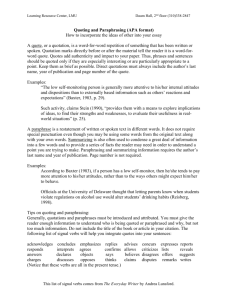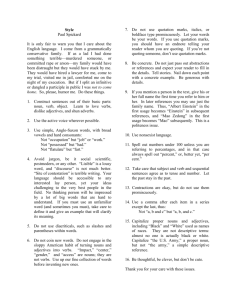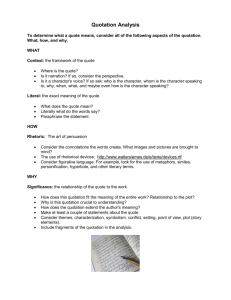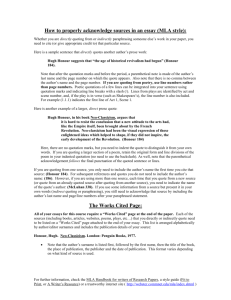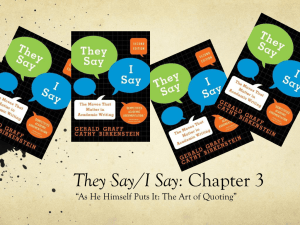Using sources effectively: Tips and tricks for integrating sources into
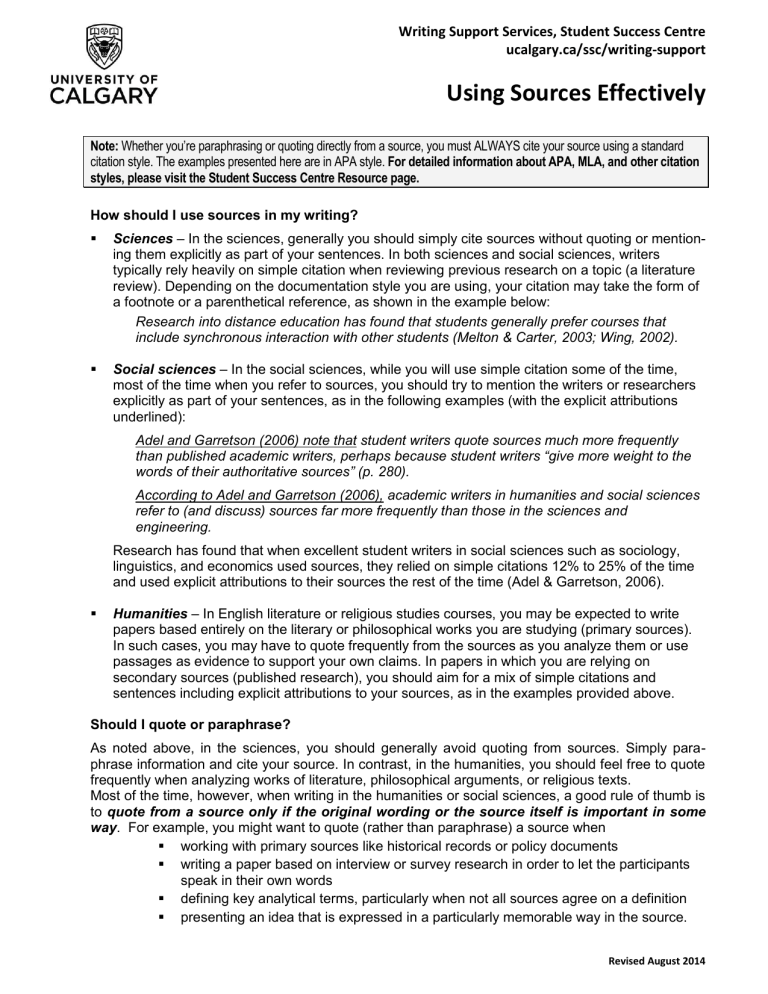
Writing Support Services, Student Success Centre ucalgary.ca/ssc/writing-support
Using Sources Effectively
Note: Whether you’re paraphrasing or quoting directly from a source, you must ALWAYS cite your source using a standard citation style. The examples presented here are in APA style. For detailed information about APA, MLA, and other citation styles, please visit the Student Success Centre Resource page.
How should I use sources in my writing?
Sciences – In the sciences, generally you should simply cite sources without quoting or mentioning them explicitly as part of your sentences. In both sciences and social sciences, writers typically rely heavily on simple citation when reviewing previous research on a topic (a literature review). Depending on the documentation style you are using, your citation may take the form of a footnote or a parenthetical reference, as shown in the example below:
Research into distance education has found that students generally prefer courses that include synchronous interaction with other students (Melton & Carter, 2003; Wing, 2002).
Social sciences – In the social sciences, while you will use simple citation some of the time, most of the time when you refer to sources, you should try to mention the writers or researchers explicitly as part of your sentences, as in the following examples (with the explicit attributions underlined):
Adel and Garretson (2006) note that student writers quote sources much more frequently than published academic writers, perhaps b ecause student writers “give more weight to the words of their authoritative sources” (p. 280).
According to Adel and Garretson (2006), academic writers in humanities and social sciences refer to (and discuss) sources far more frequently than those in the sciences and engineering.
Research has found that when excellent student writers in social sciences such as sociology, linguistics, and economics used sources, they relied on simple citations 12% to 25% of the time and used explicit attributions to their sources the rest of the time (Adel & Garretson, 2006).
Humanities – In English literature or religious studies courses, you may be expected to write papers based entirely on the literary or philosophical works you are studying (primary sources).
In such cases, you may have to quote frequently from the sources as you analyze them or use passages as evidence to support your own claims. In papers in which you are relying on secondary sources (published research), you should aim for a mix of simple citations and sentences including explicit attributions to your sources, as in the examples provided above.
Should I quote or paraphrase?
As noted above, in the sciences, you should generally avoid quoting from sources. Simply paraphrase information and cite your source. In contrast, in the humanities, you should feel free to quote frequently when analyzing works of literature, philosophical arguments, or religious texts.
Most of the time, however, when writing in the humanities or social sciences, a good rule of thumb is to quote from a source only if the original wording or the source itself is important in some way . For example, you might want to quote (rather than paraphrase) a source when
working with primary sources like historical records or policy documents
writing a paper based on interview or survey research in order to let the participants speak in their own words
defining key analytical terms, particularly when not all sources agree on a definition
presenting an idea that is expressed in a particularly memorable way in the source.
Revised August 2014
2
Adel and Garretson (2006) found that top-performing student writers in the social sciences tended to quote only 10% to 20% of the time when using sources and tended to paraphrase the rest of the time.
How should I handle quotations?
Quoting can be a tricky business. A bit of advice for quoting effectively is provided below. For detailed information about formatting, punctuating, and citing quotations and constructing a reference list in APA, MLA, or other formats, please see the resources in the Writing Resources section of the
Student Success Centre website.
Formatting quotations
Use quotation marks “like this” around words taken from a source. If a quotation is over 40 words
(in APA style)
or four typed lines
(in MLA style),
present the passage in double-spaced inset block format without quotation marks, and cite your source. Note that even if you cite your source, failure to use quotation marks (or inset block format) for borrowed wording constitutes plagiarism.
Cite a page number for all quotations.
Length & clarity
Quote only as much as you need to. Use ellipsis (three spaced dots) to signal the omission of words or sentences when quoting. Add a fourth dot if the ellipsis runs over the end of a sentence
(as in the Halloran example below). No ellipsis is needed at the beginning of a quoted passage.
In MLA (but not APA) format, ellipsis is needed if a quotation ends in an incomplete sentence.
Use square brackets [like this] around words inserted for clarity into a quoted passage, (e.g.,
“She [John’s mother] was a difficult woman” (p. 10).)
Style & substance
Generally avoid using a quoted passage to begin a sentence. Instead, provide a lead-in for your quotations (e.g., by making it clear who is speaking).
When using a long inset quotation, try to introduce it with what could be a complete sentence followed by a colon. Here’s an example (in APA format):
As Halloran (1990) notes, correct grammar has long been associated with social class:
In the competitive middle-class society of the nineteenth-century, speaking and writing and writing “correct” English took on new importance as a sign of membership in the upper strata. . . . [B]y attempting to impose a “hyper-correct” dialect on the generally privileged students at Harvard and the other established liberal arts colleges, Hill and others may actually have strengthened the linguistic obstacles to upward mobility. (p. 167)
When revis ing, make sure that you’ve adequately established the significance of quoted material and that the material actually supports the point you are making in your paragraph.
What verb tense should I use?
Use the past tense when referring to a researcher’s activity, even if the research is recent.
e.g. Soo (2007) investigated the link between gender and income among social workers and found …
The link between gender and income . . . was investigated by Soo (2007).
3
Use present perfect tense ( has/have + the past participle of the verb ) when referring to topics of research rather than to a specific researcher’s activity.
e.g. The experiences of abused women have been investigated (Davis & Srinivasan, 1997).
Several studies have focused on learning styles (e.g., Lea, 1998; Neff, 1998; Song, 2003).
Use present tense when making general statements about reality (as supported by research) and when presenting actions, events, and quoted passages from works of literature. e.g. Spousal abuse appears to have a complex set of causes (Davis & Srinivasan, 1997).
Jane initially sees Emily as a friend but later comes to view her as a competitor.
What are some lead-ins that I can use to refer to sources in my sentences?
Here are a few lead-ins (or verbs of attribution) that you might find useful in your papers: according to acknowledged assessed assumed argued agreed asserted attributed... to attempted to analyzed believed called cited challenged claimed compared concluded confirmed considered contended that continued contradicted correlated... critiqued criticized defined demonstrated described determined developed disagreed discovered
discussed
emphasized established examined extended...to explained explored evaluated felt focused on found highlighted hypothesized identified ignored insisted interpreted investigated listed located maintained meant mentioned neglected noted observed outlined
pointed out posited presented proposed
provided proved (avoid) questioned quoted (avoid) recommended recognized related .... to ... reported revealed
reviewed saw said
… as showed stated stressed studied
suggested supported surveyed tested theorized took the view that thought traced underscored underlined used verified viewed
wrote
In Table 1, the bolded verbs were found to be among those most frequently used in good student writing (Adel & Garretson, 2006).
Here are a few pitfalls to watch out for when referring to sources:
Avoid using “proved” when writing in the humanities and social sciences; instead, try verbs like
“found,” “demonstrated,” or “established.” In the sciences, “proved” may be appropriate in certain circumstances (e.g., when referring to foundational research), but it should be used with restraint.
When referring to sources, aim for precision and variety. Avoid overusing “said” and “stated.”
Consider the distinctions between noting, proposing, arguing for , and claiming something.
When referring to researchers, avoid using the verbs
“felt” and “thought.” Instead, use stronger verbs, like “found” or “concluded.” The verbs “felt” and “thought” may be appropriate if you are
4 referring to the experiences of research participants.
Unless you are saying that one writer actually used the words of another writer, avoid using the verb “quoted” when referring to a source or introducing a quotation.
Watch out for anthropomorphism —illogically using verbs that require a human subject with inanimate objects. For example, keep in mind that a study cannot conclude something or control for variables; only researchers can do those actions.
References
Adel, A., & Garretson, G. (2006, September). Citation practices across the disciplines: The case of proficient student writing . Paper presented at the conference of The European Association of
Languages for Specific Purposes, Zaragoza, Spain
.
Halloran, S. M. (1990). From rhetoric to composition: The teaching of writing in America to 1900. In
J. J. Murphy (Ed.), A short history of writing instruction from ancient Greece to twentiethcentury America (pp. 151-182). Davis CA: Hermagoras Press.

